The Integrated Marketing Campaign Toolkit
Published:

Introduction
Growing pains – every business has them. And as your marketing team grows, it’s easy to lose sight of the goals that matter. It starts slowly: silos form as marketers execute on a million different things at once. Busy work increases. Then, before you know it – and despite everyone giving 110% – you’re falling behind on your numbers and losing brand recognition.
We’ve all been there. Back in 2019, our marketing team was growing fast. It was an exciting time, but also one with pain points. As the team grew, more and more signals were crossed.
It became clear that we needed a better way to tie activities together, roll those activities up to revenue, and create more cohesion overall.
That cohesion came in the form of integrated marketing campaigns.
Using integrated marketing campaigns, we turned our siloed teams into one unified marketing machine. Today, even after transitioning to become a remote-first company, our marketing is more aligned than ever.
Now, we’re sharing how we did it and how you can too.
Written in collaboration with Asana, the leader in work management, this toolkit offers best practices and templates for managing integrated marketing campaigns and growing marketing teams.
In this book, you’ll discover:
- A complete breakdown of the integrated marketing campaign framework
- Best practices for managing your marketing team’s strategy and shifting priorities
- An integrated campaign launch kit and UTM builder to help you measure, track, and analyze your integrated marketing campaigns
- Templates and steps to operationalize your marketing campaigns, offers, activities, and calendars
What are integrated marketing campaigns?
In Asana’s Anatomy of Work Index Report, survey respondents said they spend 60% of their day on “work about work” as opposed to meaningful work. That includes busy work like searching for information, communicating project updates, and chasing down deliverables from illusive coworkers. Sounds exhausting, we know (because we’ve been there too).
But employees aren’t the only ones feeling stretched thin. For marketing managers, getting siloed teams on the same page can be like herding cats.
With integrated marketing campaigns, marketing leaders can action and align their teams, create consistency around processes, and minimize frenzied deadlines. Integrated marketing campaigns also help:
- Bring together different channels to maximize your content’s reach
- Create a cohesive go-to-market (GTM) strategy across channels
- More easily roll-up marketing activities to revenue
Integrated marketing campaigns use a hierarchical approach to help you identify core themes, personas, and deliverables so you can execute a more effective marketing strategy.
The anatomy of an integrated marketing campaign
Below is an illustration of an integrated marketing campaign hierarchy.
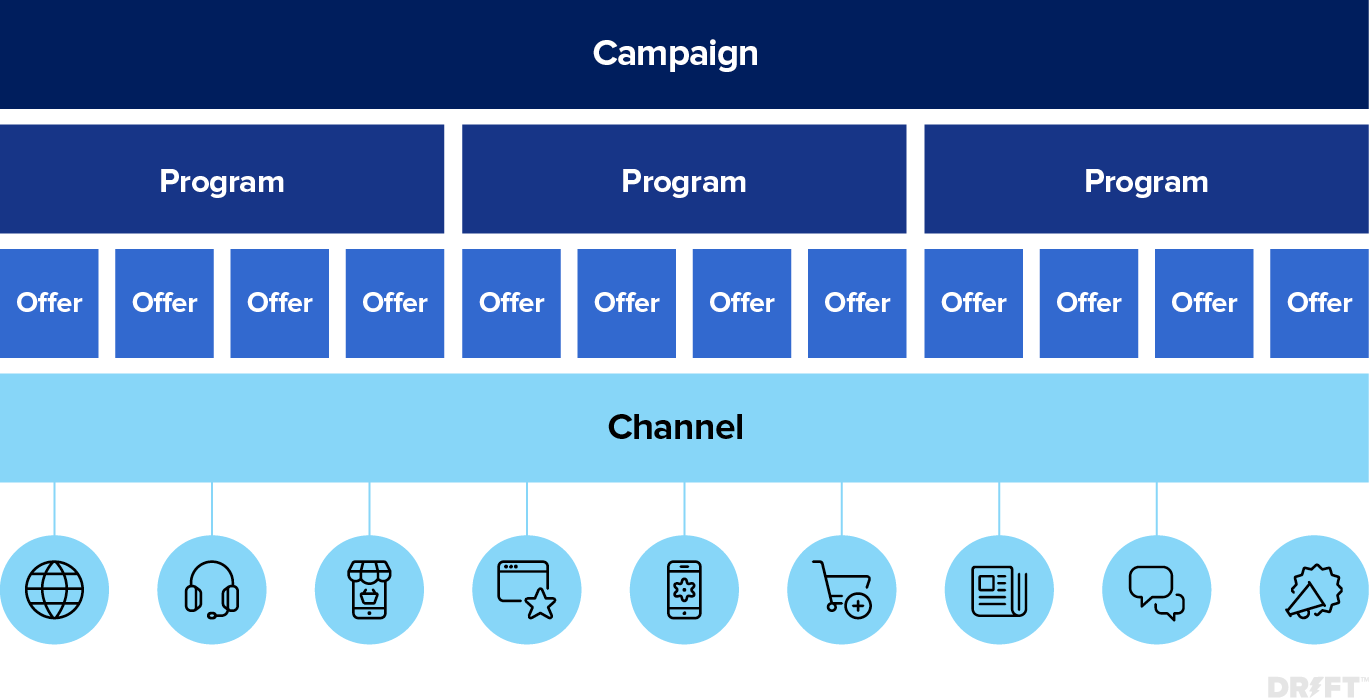
A campaign is the top-layer of an integrated marketing campaign. Campaigns ground the tactics, programs, channels, and offers below it. Marketing teams typically run more than one campaign at a time.
Programs live underneath campaigns and focus on a specific target audience and core theme. In an integrated marketing campaign model, you may have campaigns that run longer than a quarter, with programs shifting more frequently. Below programs are offers. Offers draw buyers into your marketing funnel and provide additional value for customers. Offers can be events, ebooks, webinars, or other related collateral.

Finally, you have channels. Channels are how you deliver your offers and marketing narratives to the world. Not every channel will be right for every offer. For example, say you’re running a customer campaign and one of your offers is a customer-specific virtual event. In that case, you probably wouldn’t promote the event heavily across your social media channels. You’d take a more surgical approach via email marketing campaign or have your customer success team reach out personally to invite customers to attend.
Marketing teams will always tailor the integrated campaign process to fit their needs. What’s important is that your team is aligned around shared activities and working in lockstep to drive results and pipeline. Even Asana and Drift have slightly different takes on who owns what in an integrated marketing campaign. Still, our objectives are the same: the unification of our go-to-market strategies and marketing teams.
Additionally, depending on the bandwidth of your team, the number of integrated campaigns you run per quarter will differ. And that’s okay! Integrated marketing campaigns should reduce extraneous work and rally everyone around the marketing activities that will have the biggest impact on your goals. Avoid overstuffing your calendar with too many demands, and be critical of bandwidth during the planning process.
Align integrated campaign content with the buyer’s journey
The buyer’s journey has become increasingly complex. Today, the average number of stakeholders in a B2B sale is 6.8. And with the advent of new technologies and digital channels, the amount of potential touchpoints has also grown.
Programs address the personas and ideal customer profiles (ICP) within an integrated campaign, as well as the channels they frequent.

But this framework doesn’t show whether you have the right content for buyers throughout their journey. To avoid messaging gaps in your integrated marketing campaigns, consider embedding buyer journeys into your planning process. You can then bucket offers into different stages of this journey, like in our example below.
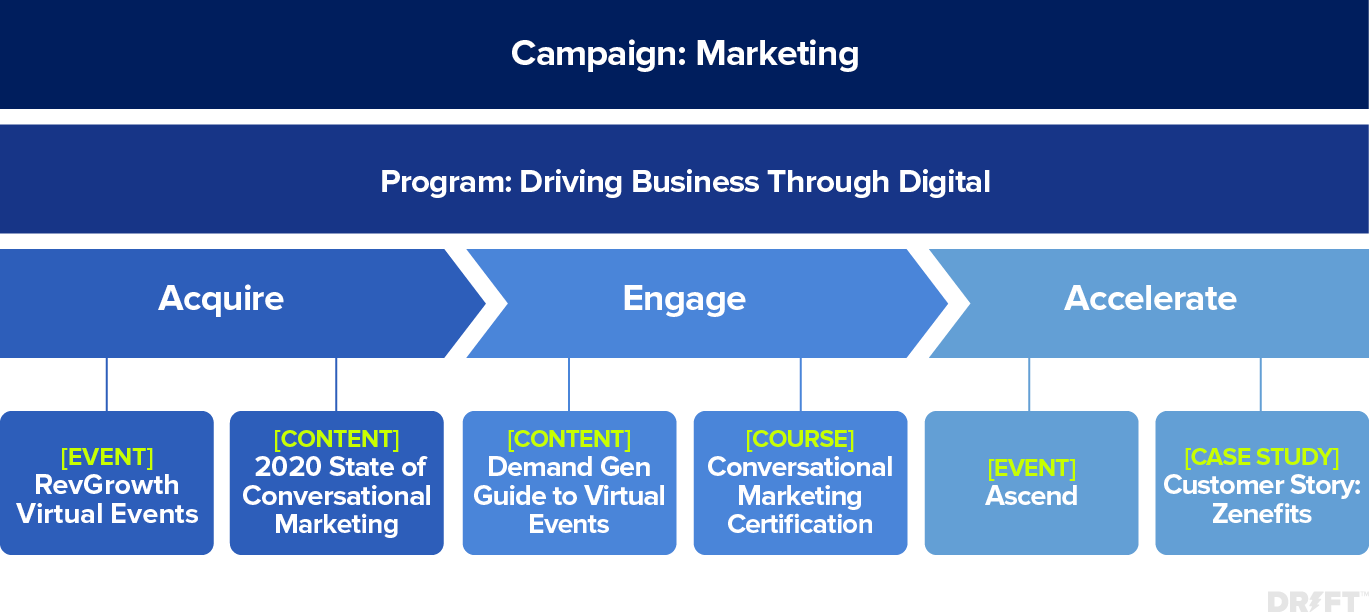
The integrated marketing campaign planning process
An integrated marketing campaign planning process defines the steps and responsibilities of marketers within an integrated campaign. This process should narrow down a campaign’s programs, offers, and tactics, and give hard deadlines for deliverables.
There are several high-level milestones this planning process should follow:
- Hold a quarterly leadership meeting to discuss core themes in go-to-market messaging
- Create and share program narratives with the marketing team
- Identify campaign offers for each program based on these narratives
- Choose the marketing channels and tactics to get offers in front of the right audience
- Have leadership review and approve programs and offers
Below is an overview of the owners, participants, and activities that happen at each of these milestones. Owners here will depend on your marketing team’s structure, so adjust accordingly, and then share the planning process with your team.
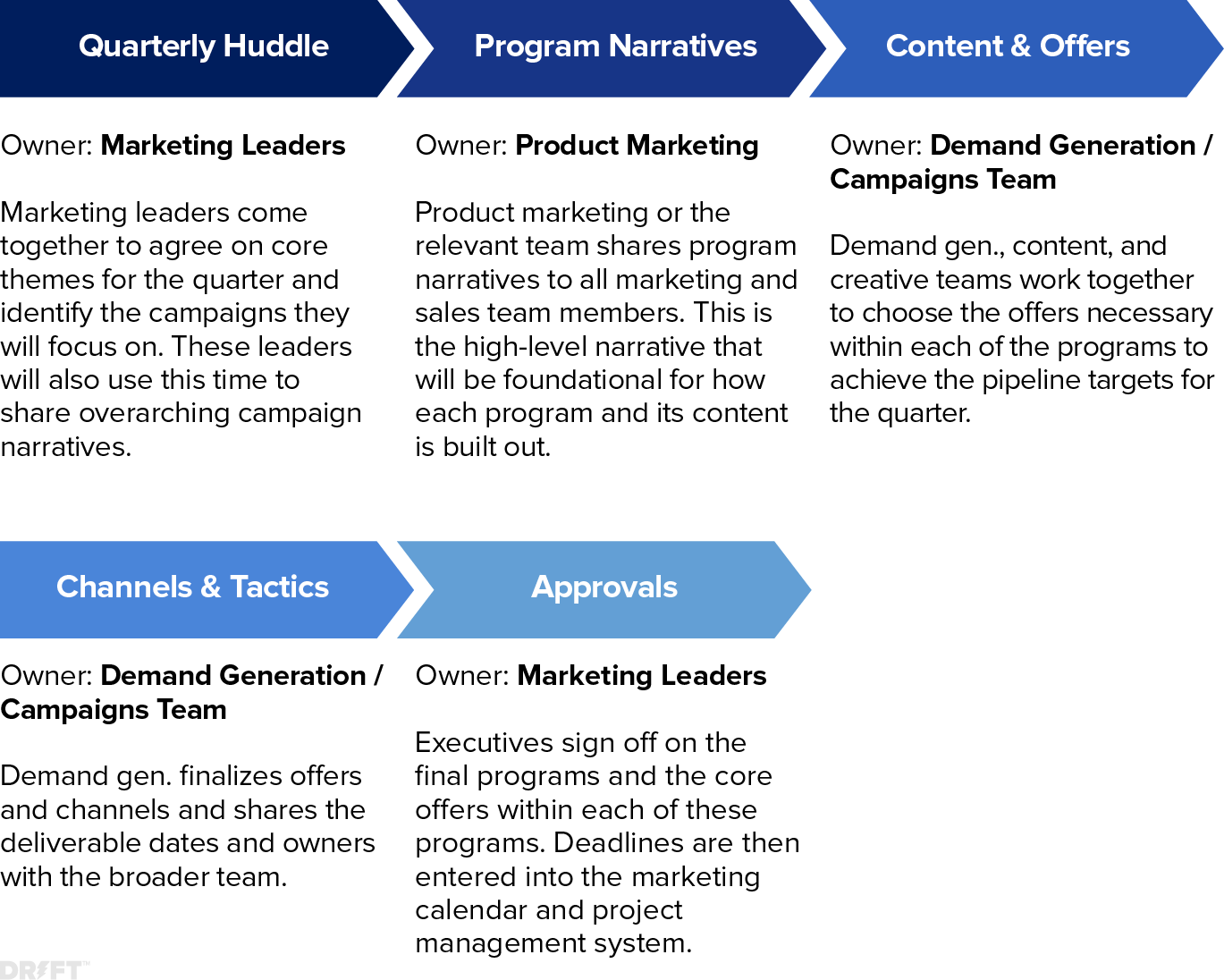
Quarterly leadership huddle
At this first stage of the planning process, marketing leaders from product marketing, demand and lead generation, content marketing, and more get together to agree on the upcoming quarter’s themes.
Start this discussion by looking at past program performance and the current company roadmap. Using all these insights, agree on the core themes your campaigns should cover to meet your revenue goals.
Create & share program narratives
Once your marketing executives sign off on the campaigns and themes, product marketing becomes the leader for stage two.
Product marketing creates the program narratives shared with the rest of the team. A program narrative is a detailed document that describes the programs under a campaign. This document includes go-to-market messaging across each stage of the marketing funnel.
We structure our program narratives with broad messaging that gets more and more granular:
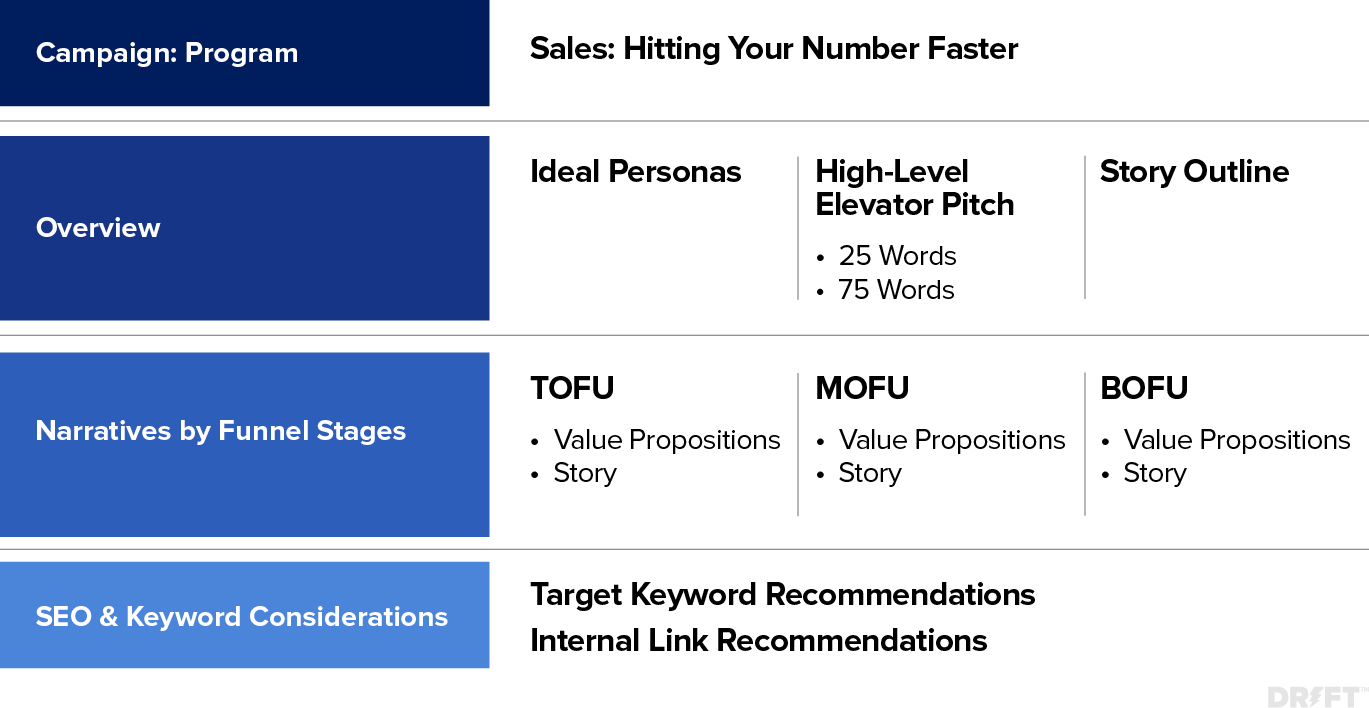
Marketing and sales use this document to tailor their conversations, campaign collateral, and messaging for buyers. Once this document is created, product marketing walks through these narratives with the other teams.
You might be wondering: Why product marketing? Our product marketers have the best insight into our personas, current market trends, and future product innovations. For those reasons, it makes sense then that product marketing would define our program narratives in unison with marketing leadership.
For your organization, it might make more sense for a different team to take the lead on narratives. Just be sure at least one person or one team is in charge of narratives at this point.
Identify integrated marketing campaign content & offers
Now that your team is aligned on messaging, it’s time to get tactical.
At this stage, the demand generation team takes over and loops in content marketing and creative. Together, they decide what offers they need for each program based on both themes and the predetermined pipeline goals.
Schedule channels & tactics
Once offers are finalized, demand generation identifies the channels and tactics that will drive people to these offers – and help the marketing team hit their pipeline goals.
For example, what emails need to be scheduled? What ads need to be created to extend the reach of a campaign? What can we do to get the right people to see this content?
Review & approve integrated campaign plans
As a final gut check, marketers should present their completed plan to leaders for final sign-off. This is a simple, but crucial milestone in the integrated campaign planning process. After all, how many of us have dealt with unrealistic deadlines and expectations in the past? This final check will mitigate moments like that.
During this step, leaders should:
- Make sure deadlines are realistic: Integrated marketing campaigns cover most marketing activities, but not all. For example, if a large website redesign process is planned for that same quarter, your creative and content teams might not have the bandwidth to execute on other planned offers.
- Double-check that the programs will meet pipeline goals: Everything must roll up to revenue. Teams should forecast to ensure their plan will help them do that.
- Identify any messaging gaps or missed opportunities: Does the plan hit all the right personas, value propositions, and audiences?

It’s easy to dismiss this step as nothing more than red tape. But alignment becomes that much more important as your marketing team grows.
Still, having all of this information scattered between slide decks and Google Docs is not ideal. Especially because things don’t always go according to plan.
Delays happen. Projects move. And jumping between tabs to update the whole team is not a great use of your time. Next, we’re sharing how to take what you learned in this chapter and operationalize it for your marketing team.
Operationalizing your integrated marketing campaigns
How do you go from planning to seamless execution? Cutting down on the “work about work” with centralized integrated campaign management is key.
Whether you’re in office, working from home, or coordinating with teams around the globe, for a truly integrated marketing campaign you need work management.
What is work management?
Work management is a systematic approach to organizing a company’s workflows – like projects, ongoing processes, or routine tasks. It’s about coordinating people and work across all levels of an organization, ensuring everyone has the information they need to tackle the work that matters most. Sounds like it was made for integrated marketing campaigns, right?
To implement a work management system, most organizations use a work management tool, like Asana, which becomes the single source of truth for everyone involved in the campaign – from adjusting timelines to assigning project managers to sharing work.
Although tasks like checking email and searching for documents may seem like small annoyances, they actually cut into a lot of your team’s time. This significantly hampers their ability to produce meaningful work without stress. As mentioned earlier, respondents in Asana’s Anatomy of Work Index spend around 60% of their time on busy work (i.e., unnecessary meetings and status checks). That leaves only 26% of their time left for skilled work – like running a webinar or writing an eBook – and only 14% of their time for strategy.
Plus, with the sudden rise of distributed work in 2020, respondents shared that a quarter of deadlines were missed, and 87% of knowledge workers reported working late to make up the difference. Something’s got to give if teams are going to stay motivated, happy, and productive.
Keep your integrated campaign on track with a work management tool
Once you and your team have finished the campaign planning, it’s time to create step-by-step processes in your work management tool. Work management tools, like Asana, provide greater transparency and accountability around projects and deadlines.

Create accountability across campaigns
Integrated marketing campaigns are a team effort. This is especially true when a team is remote or distributed across offices. For example, when you run a demand generation campaign with multiple offers, like an ebook, webinar, and blog post, you need several specialists to help execute, from content marketers to campaign managers.
When everyone is working out of the same single source of truth, it’s easy to track who is doing what and by when. To create accountability across a campaign, assign tasks with owners and due dates. Clear responsibilities and deadlines help people stay on top of their own work, eliminate duplication, and allow everyone to move faster in the same direction.
Stay on schedule with clear timelines
Try as you might to keep multiple integrated marketing campaigns on schedule, things don’t always go according to plan.
When this happens you need a way to pinpoint overdue work across all of your campaigns so you can quickly follow-up with collaborators and adjust schedules accordingly. For example, when you’re working on an ebook, if the copy isn’t finished on time, the design team’s timeline will have to change.
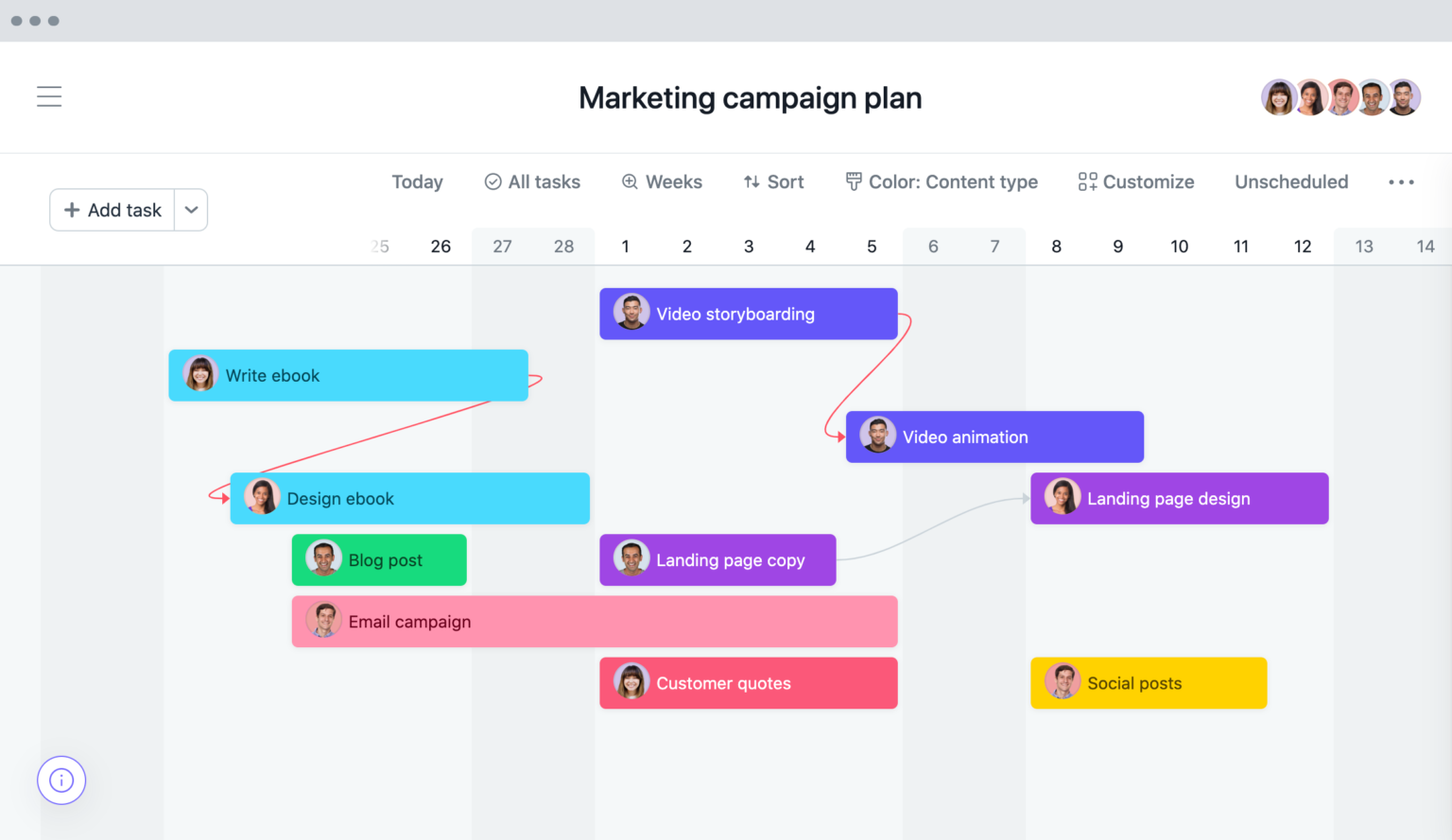
With a work management tool, you can easily get a bird’s-eye view of all tasks and zoom into those that are incomplete or past due. From there, you can click into each task to ping the assignee for an update. A timeline view is especially useful to see how due dates align – or don’t – so you can act accordingly.
Cut down on email with regular status updates
Campaigns have a lot of moving pieces. And stakeholders like to keep tabs on how projects are going. Instead of providing status updates to individual team members through email, we recommend publishing weekly or bi-weekly status updates in your work management tool.
Keeping progress updates centralized in a work management tool allows you to proactively flag at-risk or blocked work before it affects deadlines. You can also highlight recently accomplished milestones, and add links to resources or new documents. And because your stakeholders are already project members, publishing an update will automatically notify all of them at once.
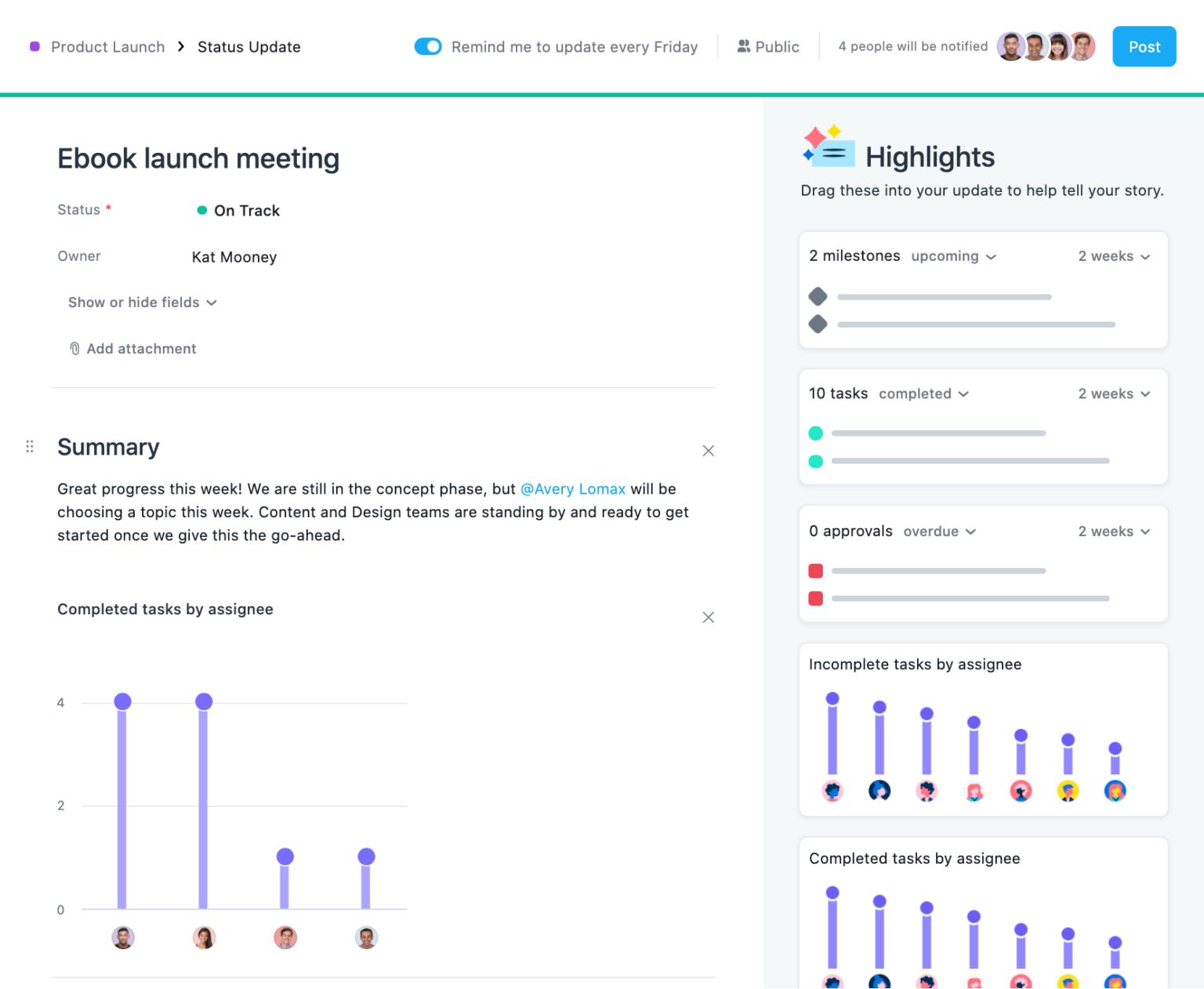
Monitor multiple integrated marketing campaigns in a central portfolio
When planning multiple integrated marketing campaigns, you need a way to stay on top of status updates. Instead of calling for endless check-ins or guessing how work is progressing across all of your projects, we recommend creating a central portfolio in your work management tool to monitor all of your team’s campaigns in one place. Portfolios offer a high-level view of each campaign’s progress, recent status updates, and your team’s bandwidth – all in real-time.
Work management tools are helping teams everywhere work better together. But how can you track progress and performance across campaigns post-launch?
Create reporting consistency with an integrated marketing campaign & UTM builder
Nothing is more frustrating than opening up Salesforce and seeing 10 different naming conventions for the same piece of content.
At the very least, this kind of poor housekeeping results in inaccurate reporting. At worst, it hurts your long-term marketing strategy. To avoid this, you need to standardize naming for campaigns, programs, and offers in your CRM. (We can hear your marketing ops team cheering now.)

When naming your integrated marketing campaigns, use a format that identifies key information quickly. For example, your naming convention could include the following:
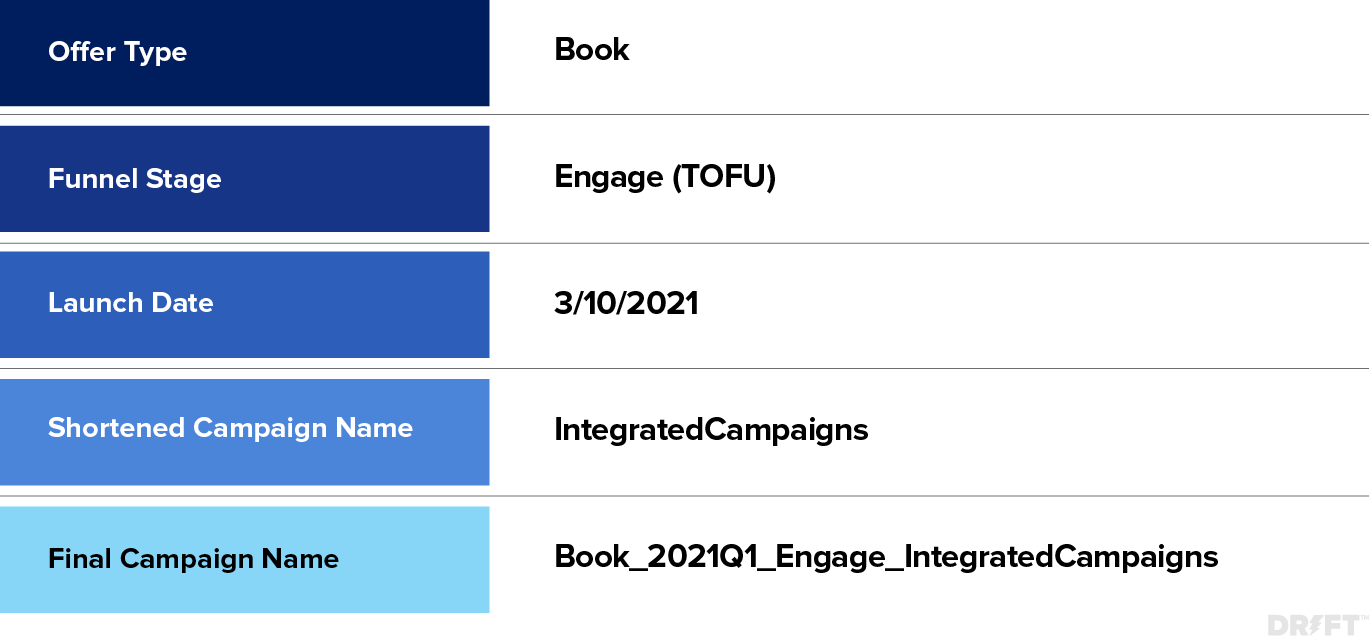
Once you have your naming conventions down, marketers should use Urchin Tracking Module (UTM) tracking links across channels. UTMs track the clicks and performance of offers across five different parameters: traffic source (i.e., utm_source), medium, campaign (i.e., utm_IntegratedCampaigns), content, and keyword terms.
There are several websites you can use to build UTM tracking links. Though we suggest creating your own UTM and campaign builder.
Feeling organized yet? We hope so. So far you’ve learned how your team can operationalize and transition marketing activities into a work management system. Now, it’s time to go one level deeper and start creating your own templates.
Creating integrated marketing campaign templates
Staying organized – even as your team and priorities grow – is a challenge without the right marketing tools – even for the most type a among us. That’s why templates are so valuable.
We use templates to:
- Align our marketing team around the same processes so we don’t miss any critical steps
- Standardize and roll out quick process changes to the entire marketing team
- Create a consistent and unified go-to-market message
- Capture our marketing team’s tried-and-true campaign processes and minimize busy work
Streamline your integrated marketing campaigns with these pre-built Asana templates:
Integrated campaign programs template
In the template below, we break down an integrated marketing campaign example by programs and offers to get a holistic view of each marketers’ contribution to a campaign.

In the Overview section of this project, you can attach program narratives or write narratives directly into Asana. (Just remember to make these documents accessible to other relevant go-to-market teams, like sales.)
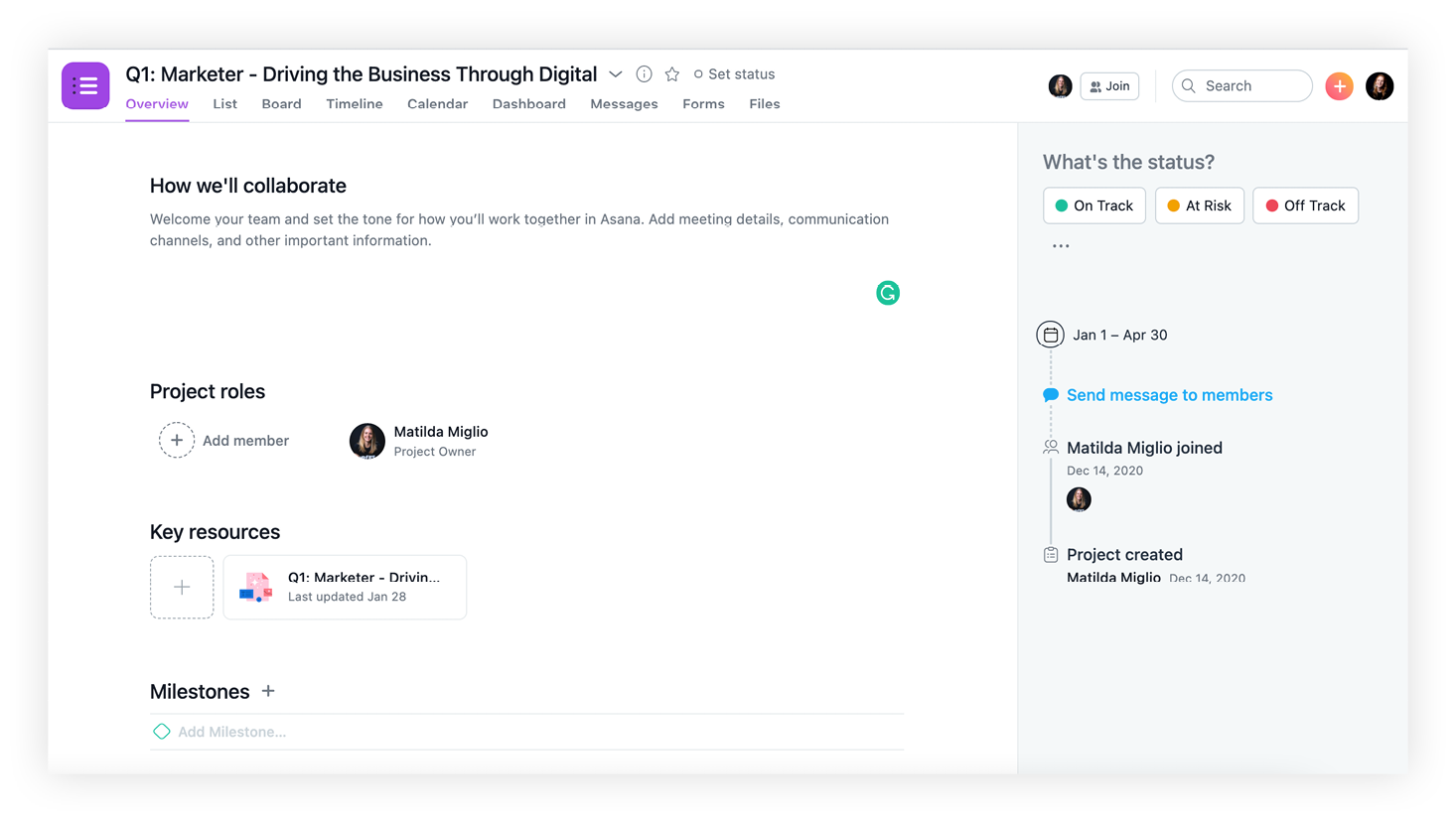
Content & offer templates
Blogs. eBooks. Webinars. Advertisements. Events. There are a lot of moving pieces behind an integrated marketing campaign. And each offer has its very own to-do list. By templating these processes you can align teams to make sure everyone has the bandwidth to get the work done.
Let’s look at a few integrated marketing campaign examples. Below is an eBook template used to launch the very book you’re reading right now! Meta, we know.
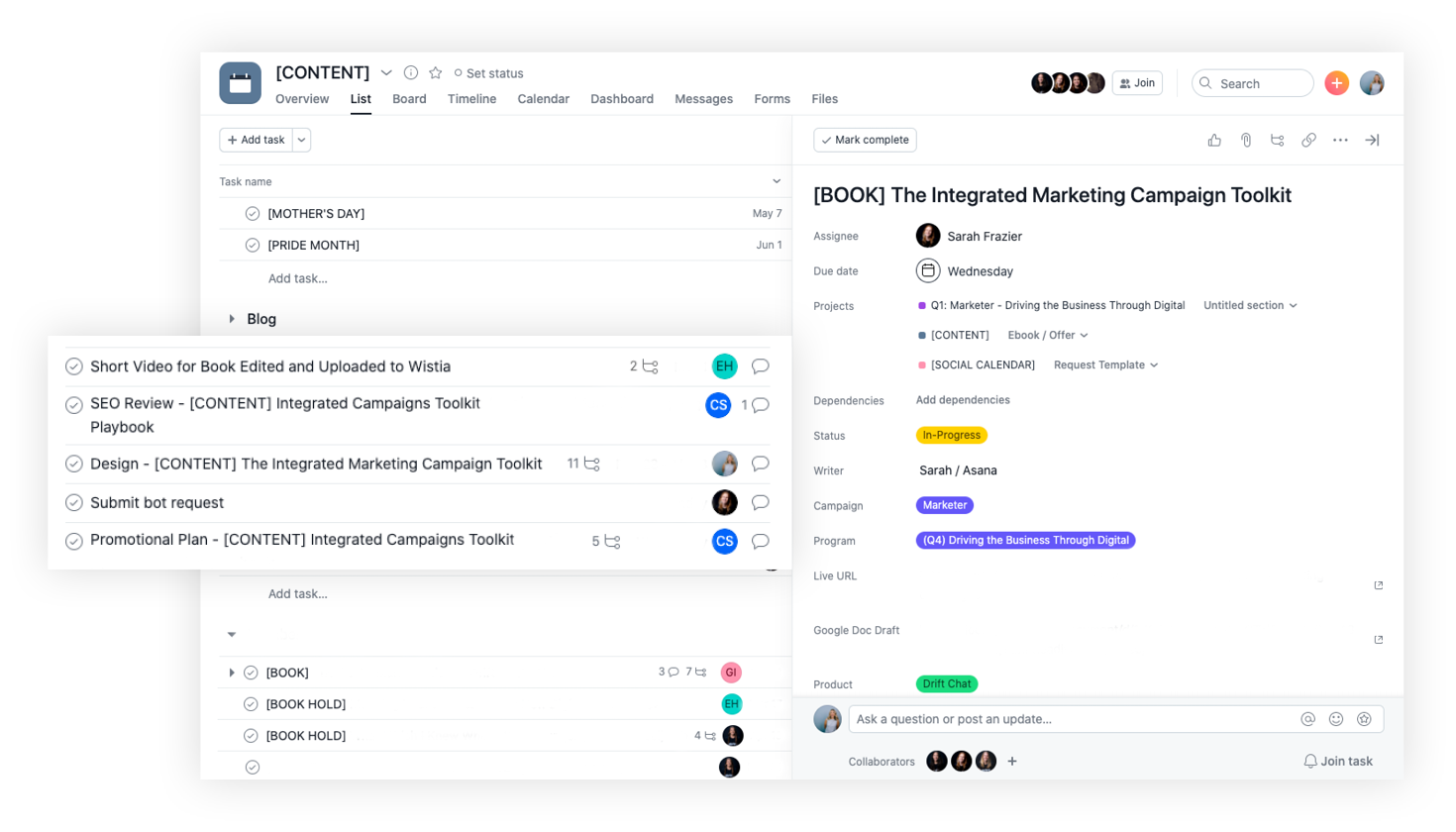
Each subtask has an assigned directly responsible individual (DRI), deadline, and to-do list. Here, we’ve also layered on dependencies. In Asana, dependencies tell your team “you can’t start step two without finishing step one.”
Once we finish writing the book draft and check the “Content Book Writing” subtask off in Asana, the creative team will be notified that they can start design. Operationalizing your process in this way reduces “busy” back-and-forth work and gives visibility into a project’s status.
Templates become more essential as offer complexity grows. Take events, as one integrated marketing campaign example. From speaker contracts to promotions to post-event follow-up – events, even on a small scale, are a lot to manage. By linking templates to team calendars you can ensure no steps or deadlines slip through the cracks. The more detailed and granular you can get with templates the better.
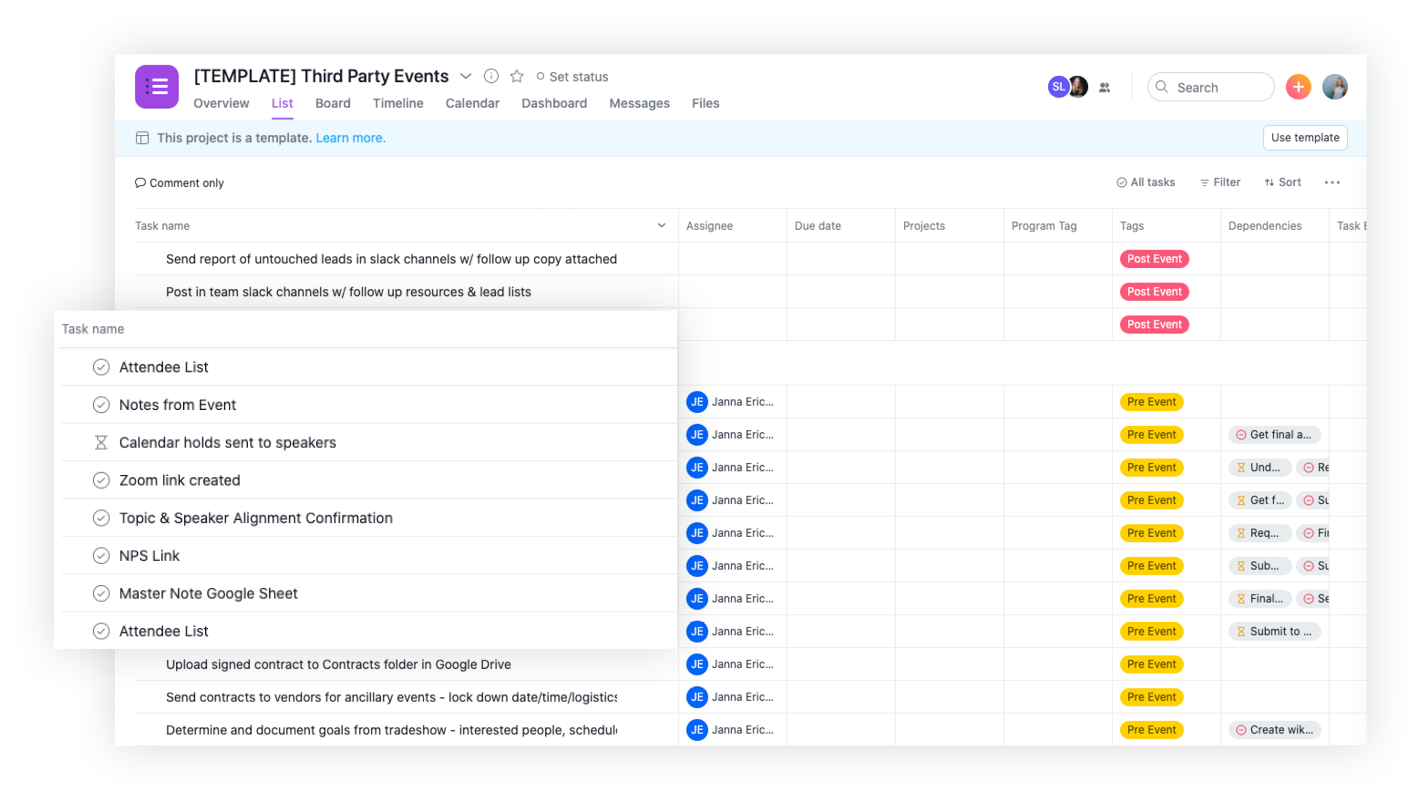
Channel calendar templates
Your marketing department likely includes teams specifically responsible for managing channels in your marketing mix like blogs, emails, and social. To keep these channels up-to-date with a steady flow of content – and everyone on your team aligned on what’s going out when – channel calendar templates are your best friend.
For example, here we have a social media calendar. A social media calendar template gives you a bird’s-eye view of all your upcoming and past social posts.
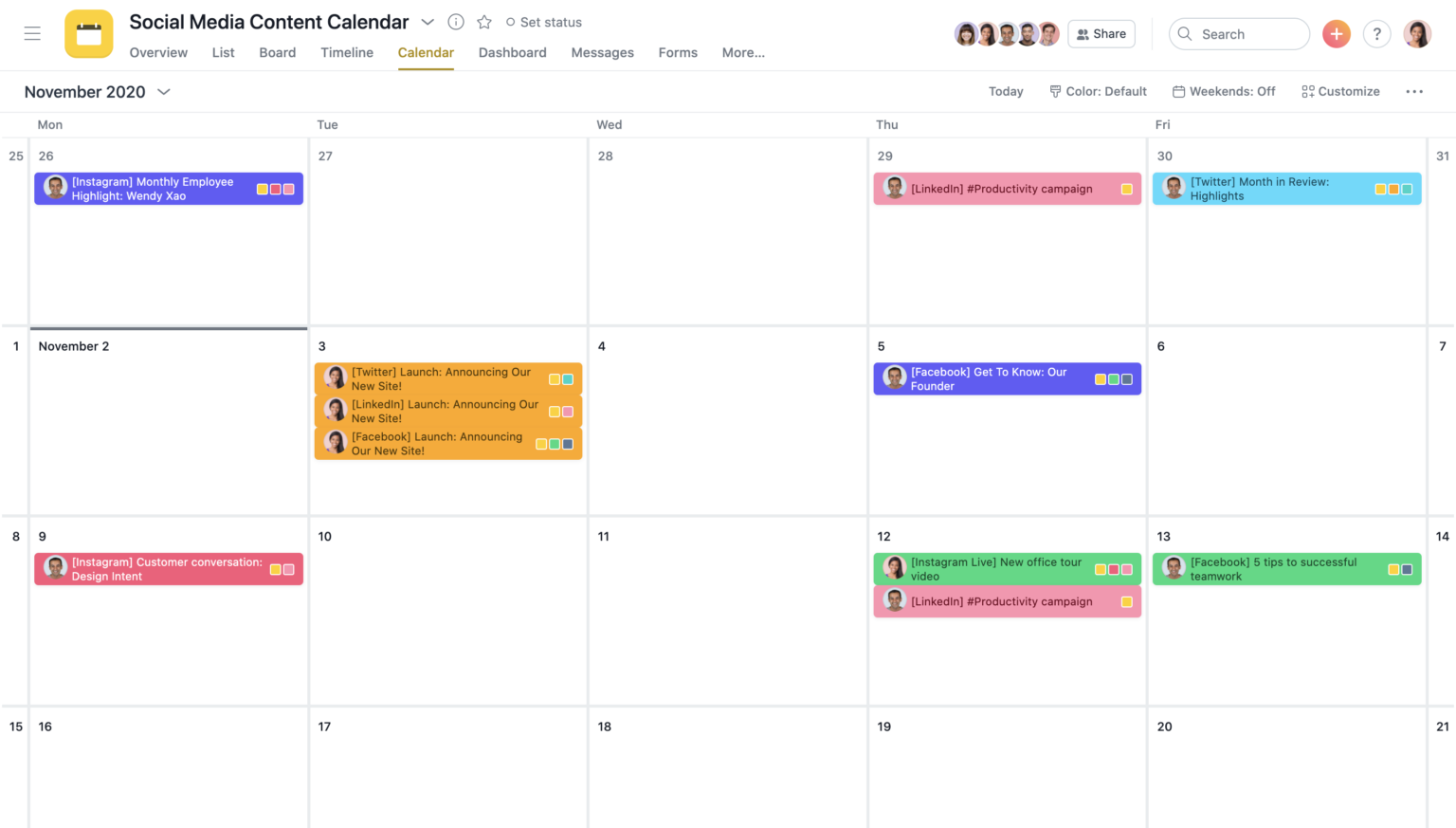
You can keep all of your work connected and automatically up-to-date across your integrated marketing campaign by adding the same task to multiple projects. For instance, if your integrated marketing campaign includes a blog post to promote an eBook, create a task for the blog post and add it to the Integrated Campaign Program, Content Offer, and Blog Calendar projects in Asana. When you update the task – whether it’s changing the due date or posting a comment – all three projects will automatically show those updates in Asana.
Meeting templates
Work management tools are great for reducing busy work. But that doesn’t mean you should stop meeting as a team all together.
We’ve all been victims of meandering meetings that “could have been an email.” Ensure your meetings are more actionable by using a meeting template. With an agenda plugged into the meeting template, everyone can walk (or dial) into the meeting knowing what will be discussed – and leave with a clear idea of next steps. For example, brainstorm meetings are great, but often feel less actionable. Having a place to source your ideas for these meetings creates more structure:
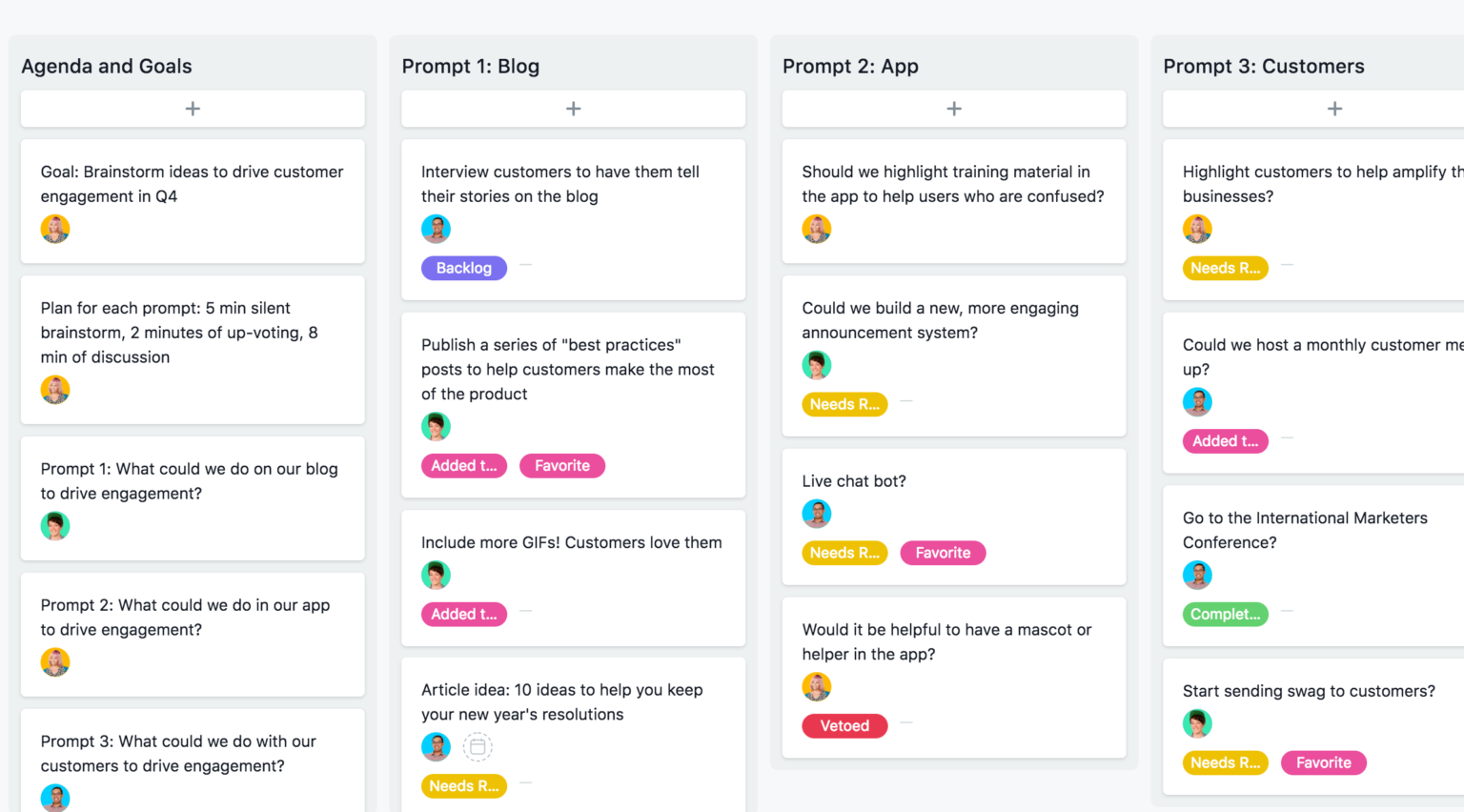
With so many marketing teams working in different locations these days, meetings are a good way to get aligned on the big picture and feel more connected while you’re at it:
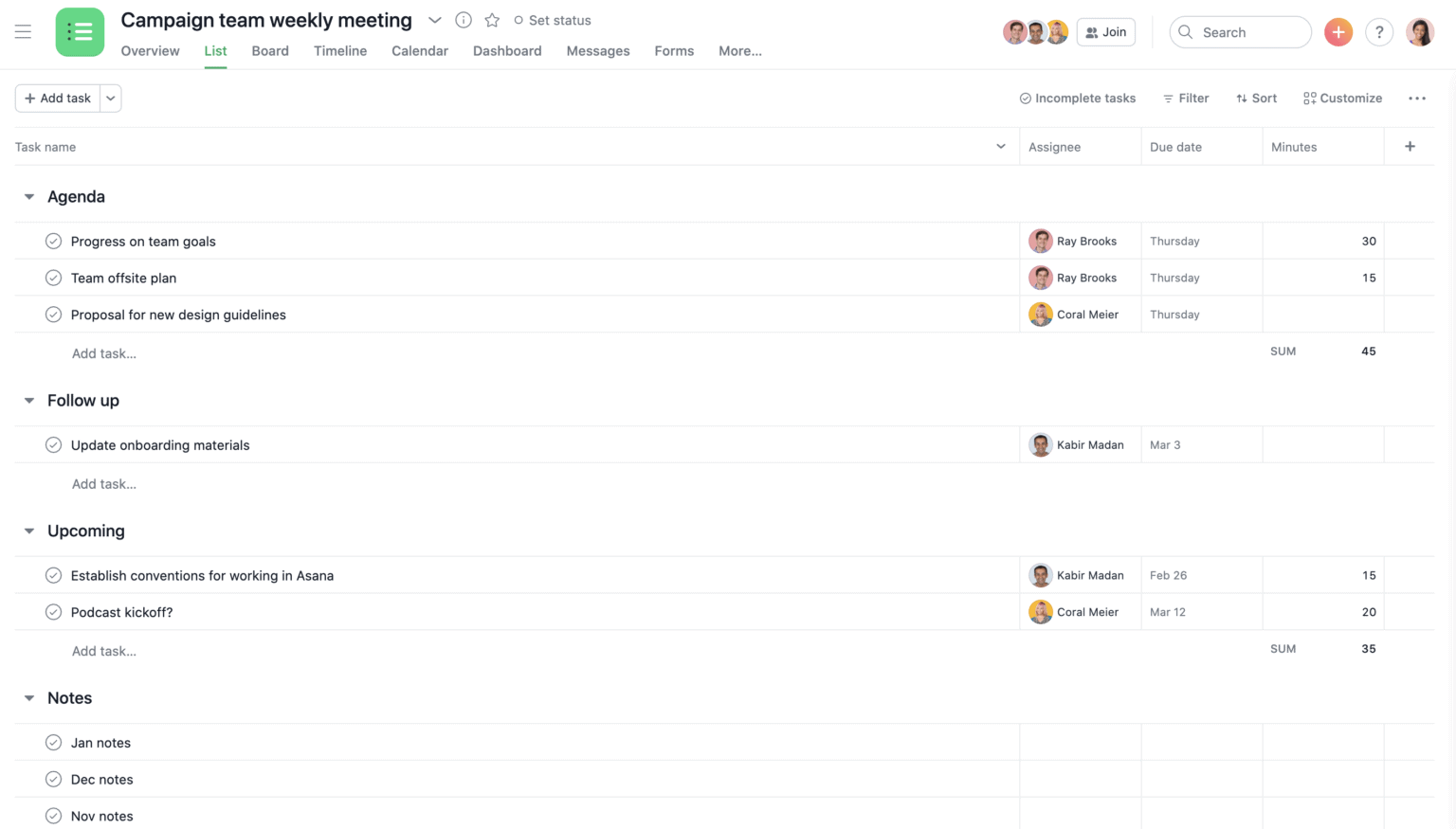
If your marketing team is agile, there’s a template for daily standup meetings, too. Even if your team isn’t running agile methodologies, brief daily standup meetings can be useful as you get closer to campaign launch day.
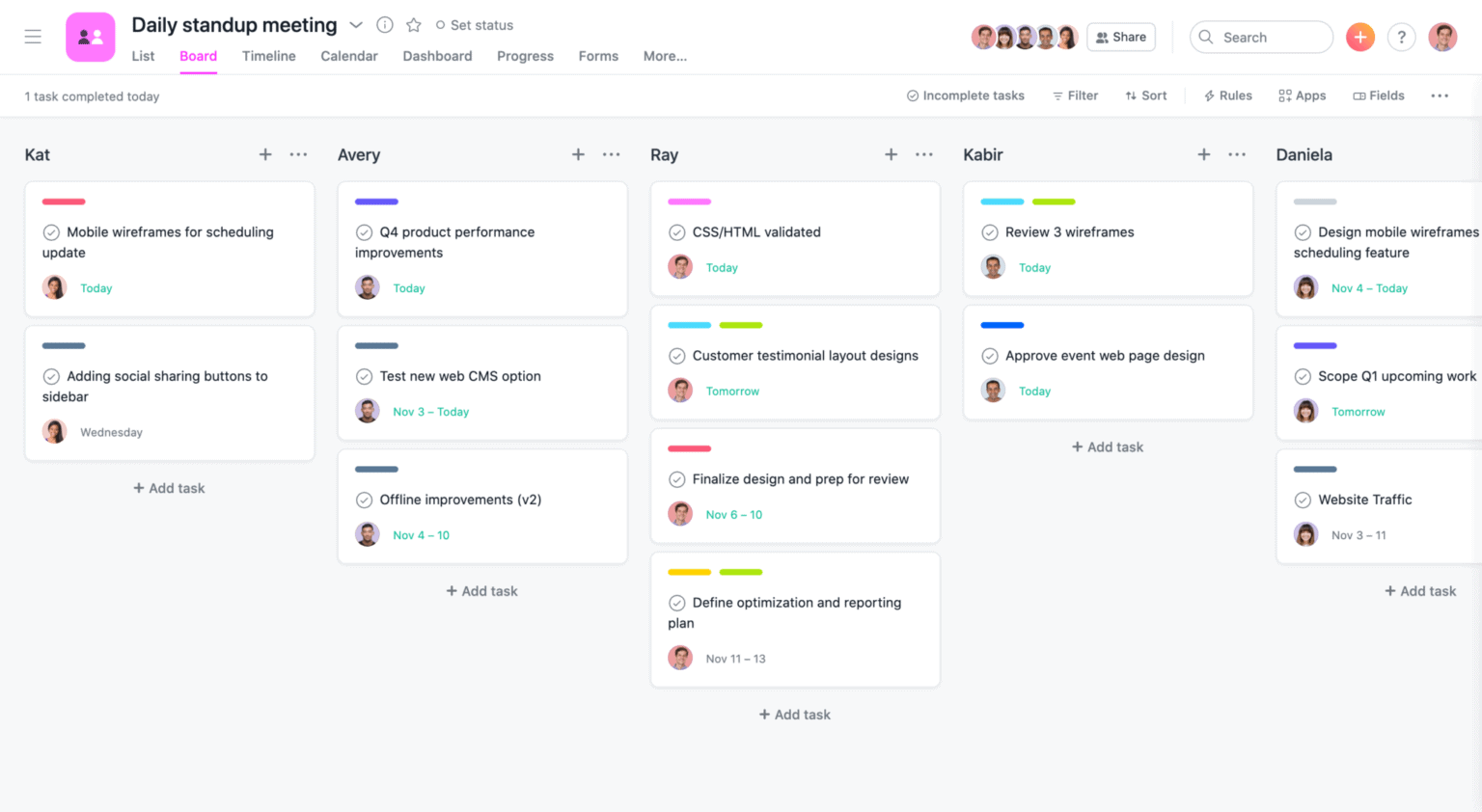
How to make these integrated marketing campaign examples & templates your own
Managing an end-to-end integrated marketing campaign requires meticulous attention to detail. That’s why we recommend capturing and tracking all of your integrated campaign information with custom fields so you can easily search for and surface projects throughout the planning process. For example, at Asana, the campaigns team uses custom fields to indicate each task’s priority and approval stage.

Every marketing team is unique and has its own way of doing things. So you can modify any of the templates we shared above to make them your own. Our team, for example, uses custom fields to connect individual offers to programs and campaigns, share live URLs, and notate offer types.
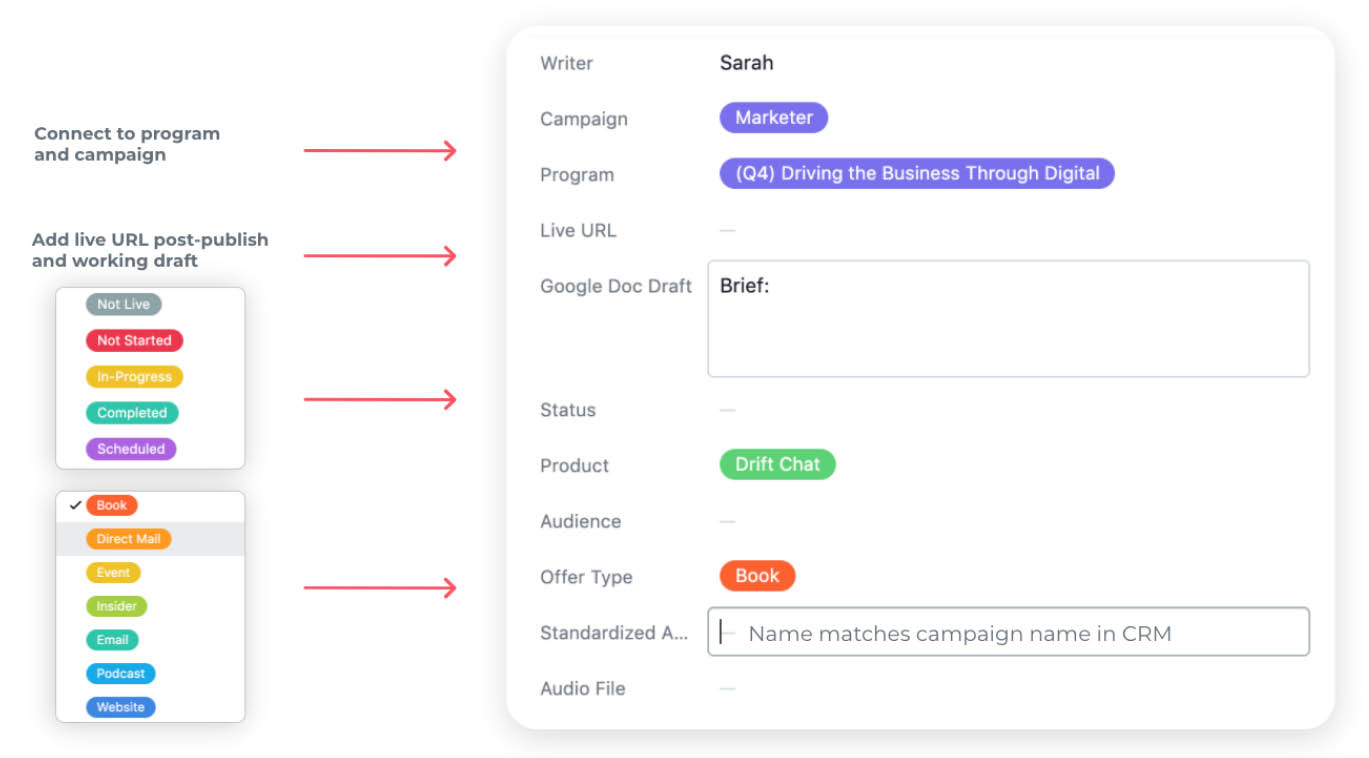
If you don’t see an Asana template for a campaign process or offer that your marketing team runs, you can always create your own custom template.
Final thoughts
Congratulations! You’re well on your way to becoming an integrated marketing campaign expert.
Although integrated marketing campaigns are complex, they don’t need to be a headache to pull off. With a solid framework and a work management tool, any marketing team can align and move together seamlessly towards the same end goals.
We hope you put the learnings from this guide to work to keep your marketing team action-oriented and aligned.
About Drift
Drift is a Revenue Acceleration Platform that helps companies engage in real-time, personalized conversations with the right customers at the right time, so they can build trust and accelerate revenue. More than 50,000 businesses use Drift to align sales and marketing on a single platform to deliver a unified customer experience.
About Asana
Asana helps teams orchestrate their work, from small projects to strategic initiatives. Headquartered in San Francisco, CA, Asana has more than 89,000 paying organizations and millions of free organizations across 190 countries. Global customers such as Accenture, Danone, Sky, Spotify, and Viessmann rely on Asana to manage everything from company objectives to digital transformation to product launches and marketing campaigns.





























